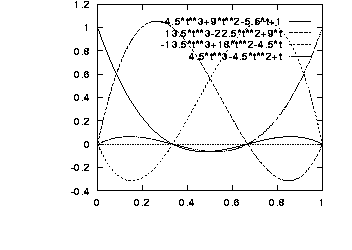
The general form is given by:
x(t) = T A_x y(t) = T A_y z(t) = T A_zwhere
T = [ t^3 t^2 t 1 ]
A = [ a3 ]
[ a2 ]
[ a1 ]
[ a0 ]
We know the following four constraints hold for x (and analogous
constraints hold for y and z):
t=0: P0_x = [ 0 0 0 1 ] A_x t=1/3: P1_x = [ 1/27 1/9 1/3 1 ] A_x t=2/3: P2_x = [ 8/27 4/9 2/9 1 ] A_x t=1: P3_x = [ 1 1 1 1 ] A_xWriting this in terms of a vector equation gives:
G_x = B A_xSolving for A_x gives:
A_x = B_inv G_xThus,
x(t) = T A_x x(t) = T B_inv G_x x(t) = T M G_x ( M = B_inv )where
[ -9 27 -27 9 ]
M = 0.5 [ 18 -45 36 -9 ]
[-11 18 -9 2 ]
[ 2 0 0 0 ]
The basis functions are given by T M:
f1(t) = -4.5t^3 + 9t^2 - 5.5t + 1 f2(t) = -13.5t^3 - 22.5t^2 + 9t f3(t) = -13.5t^3 + 18t^2 - 4.5 t f4(t) = 4.5t^3 - 4.5t^2 + tThese look as follows:

A(0) = (0,0) A(1) = (1,1) B(0) = (1,1) B(1) = (3,6)A(1) = B(0), therefore we have atleast C0 (and G0) continuity.
A'(1) = (1,2t) evaluated for t=1, giving (1,2) B'(0) = (2,3t^2 + 4) evaluated for t=0, givine (2,4)We see that we do not have C1 continuity.
dy/dx for A(1) = 2/1 = 2 dy/dx for B(0) = 4/2 = 2We therefore have G1 continuity.